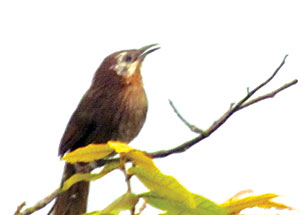 BIRD DIP: Scott DeLisi in Dhading last month, when he spotted and photographed a rare spiny babbler. |
American ambassador Scott DeLisi has reconciled himself to leaving Nepal without a new constitution, and he would have been happier if there had been more progress in making Kathmandu better prepared for future earthquakes. But what would have made him really sad is if he had not spotted the spiny babbler before he left Nepal later this month.
An avid birder, DeLisi finally fulfilled his wish to spot and photograph the bird species found only in Nepal at Nalang of Dhading last month. After years of doggedly pursuing this elusive bird on Phulchoki and elsewhere, he finally tracked it down pushing his "life list" to 1,084 bird species, 193 of them from Nepal. A life list is a tally of birds spotted and identified for the first time by a birder.
"We would have felt very bad to leave Nepal without seeing the spiny babbler, and we'd have had to come back for it," DeLisi said as he prepared to leave Kathmandu to take up his new assignment as US ambassador to Uganda.
The bird bug bit DeLisi and his wife, Leija, when he was posted to Botswana in 1997 and he found that while big animals like lions and giraffes were sometimes hard to see, birds were always around. Nepal has 871 species of birds, eight per cent of the total found in the world, and 130 of them are threatened because of habitat destruction and the disappearance of water bodies. Ten species of birds that were recorded here in the past are either extinct or have been extirpated, according to Bird Conservation Nepal (BCN).
DeLisi says that is what fascinated him about birdwatching: the intellectual challenge of finding and recording individual species, their unique markings, their calls, and the way they change their behaviours at different times of the year. "The more you look at birds, the more you are taken in by their incredible variation and the impact they have on the ecology, and how fragile their existence has become," DeLisi says, holding a computer printout of his life list.
DeLisi and Leija are very strict on themselves about recording a new species on their list. They don't tick off a bird if they have just heard its call, or caught a glimpse as it flies by, especially if it is one of those "LBJs" (little brown jobs). "We are very picky, we don't list a ruby-throated singing thrush just because we heard it. If we can't be sure, we don't tick it."
 The bird species found only in Nepal. |
We ask Leija DeLisi if their hobby has made her husband more easy-going. "He is already a very calm, composed person," she answers diplomatically, "birding gives him a chance to forget about the office for a few hours here and there and scouting about for new birds to add to our life list is quite a satisfying way to soothe the mind."
Although DeLisi's life list is respectable, he doesn't even come close to another US diplomat, Peter Kaestner, whose list has 8,200 of the world's 10,000 or so bird species. DeLisi dismisses with a laugh any link between his hobby, and his recent postings to countries which are rich in birdlife.
"The best part of birding in Nepal is the terrain," he says, "in Africa you spot birds from the back of jeeps because there are animals around that could eat you. But here you are always climbing mountains looking for birds. And it is the tremendous backdrop that gives birdwatching in Nepal its distinctive edge."
DeLisi is a life member of BCN, and has been a roving ambassador for birds during his three-year tenure here in Nepal. "My main worry is whether my grandchildren will ever see the Bengal florican which is on the verge of extinction," says DeLisi, "but I am really happy that many young Nepalis are birdwatching, and they are aware of the urgent need for conservation."
Kunda Dixit


